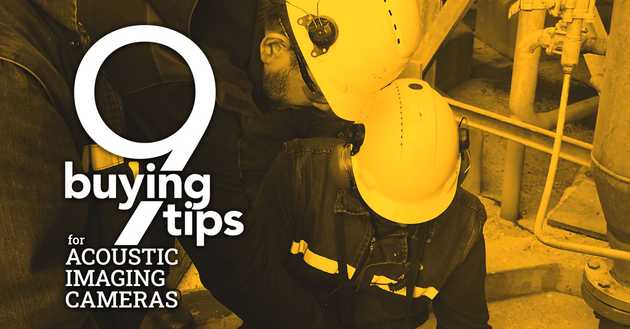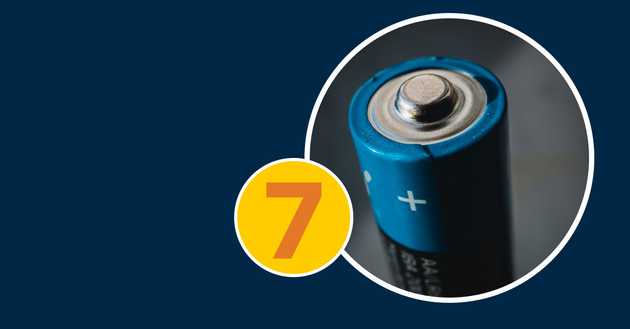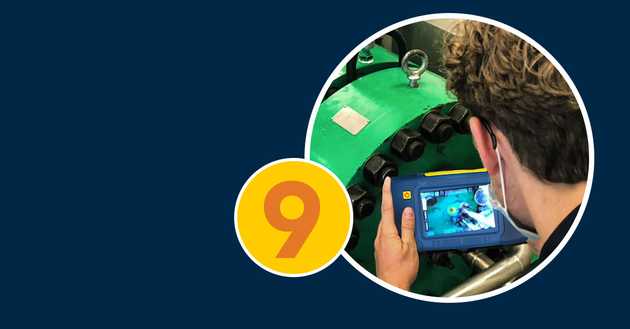Considering an Acoustic Imaging Camera? Read These Buying Tips First
Editor’s Message
Each year the condition monitoring world experiences innovation at some level, be it great or small. Even through a pandemic, leading tech companies continue to transform their solutions for the greater good of reliability. A recent example is the arrival of acoustic imaging camera technology, also known as ultrasonic imagers.
Acoustic imaging cameras combine extremely sensitive multi-frequency sound sensors with digital imaging technology to provide ultrasound inspectors with a clear picture – or video – that illustrates precisely where an ultrasound source originates. By combining our vision sense with our hearing sense, a more compete outcome is possible for certain airborne ultrasound inspections.
Now, mapping the origin of a sound to its source through imagery is an innovative breakthrough, but for someone who has followed the ultrasound market for more than thirty years, I am not surprised by these developments. Let us not forget history. Ultrasound has been with us for a long time. The notion that sounds existed outside the limited range of human hearing was first discovered in the late 1800’s. Some 130 years on, Pierre Currie’s research with piezo electrics remains as relevant today as it was when the first SONAR techniques provided ship’s captains a solution for navigating deadly icebergs. Today, ultrasound offers improvements to our lives through medical, industrial, navigational, and cleaning applications.
Allan Rienstra, SDT Ultrasound Solutions
What Type of Buyer Are You?
When new technology first hits the market, predictable buying patterns emerge. Manufacturers love the early adopters; leading edge consumers who are always first to own the latest and greatest gadgets the market has to offer. These mavens serve as a proving ground for new tech and often, their input helps steer the development for second and third product generations. Early adopters exist in sharp contrast to the “wait and see” crowd.
The wait and see crowd prefer to remain conservatively on the sidelines. They want assurance the technology will live up to its hype before opening their own wallets. If it is a passing trend, they do not want to risk their money – and ego – buying something that might end up sitting on the shelf. If the technology does take hold they will still be waiting in line when the next release is ready, preferring that the early adopters do the testing for them. Eventually, when they do come aboard, their patience is rewarded by a product with most of the early problems ironed out.
For both the “early adopters” and “wait and see” users, buying tips from a trusted source help relieve the stress associated with selecting their first ultrasound camera. Afterall, the investment is considerable and there may only be one chance to get it right. As someone who has lived his entire career inside the wonderful world of ultrasound, I am happy to share my insights about what you should look for in an acoustic imaging camera. This article identifies which features you should consider as “must haves” and which ones are fluffy bits of window dressing, only there to distract buyers from less obvious deficiencies.
My Buying Tips:
-
Do not buy brand for brand’s sake alone.
Innovations often come from the most unlikely origins, and when they do, they are honest and authentic.
Many of the ultrasonic imagers emerging today share similar humble beginnings. Born and nurtured by underfunded, tech-savvy start-ups, they eventually find their way to market by hitching themselves to well established brands. Be mindful of this when shopping for your camera. The biggest brands may make the louder noise when it comes to trumpeting their marketing message; make sure the solutions they offer are equally capable of detecting the quietest noises in the loudest surroundings.
-
Take a peek behind the curtains.
When manufacturers develop new products, they know they must compete for the attention of the early adopters first. Some will dress up a product with features and functions that make it standout, but do not necessarily add top priority value.
This approach can confuse buyers into choosing their camera based on fluffy features rather than performance. To avoid being duped, continually ask yourself why you want an ultrasonic imager in the first place. For my money, the emphasis should be placed on sensitivity and detectability. An acoustic imaging camera should be capable of detecting multiple types of defects in varying conditions. Do not allow yourself to be distracted by less relevant window-dressing features.
-
Buy an all-purpose camera.
Some acoustic imaging brands promote one camera model for finding compressed air leaks, and another for electrical assets. Really? Do we need two cameras to perform the same basic job? Steady now!
Using ultrasound to detect partial discharge in electrical assets and leaks in compressed air/vacuum systems has existed in tandem for five decades. The jobs were always performed perfectly using filtered sensors tuned in the range of 35-40kHz. This frequency choice has proven optimal for detection performance set against the contrast of loud, noisy, industrial factories. It takes into consideration distance between source and sensor, directionality of signal for fast pinpointing, and performance in environments characterized by elevated levels of audible background noise.
The turbulent characteristics of these defects have not suddenly changed. They are as detectable today at 40kHz, as they were in the 1970’s. There are no new technological discoveries or breakthroughs that warrant using a higher frequency for electrical discharges. In fact, higher frequency signals have shorter wavelengths, attenuate faster, and travel shorter distances, hampering their detectability over long expanses.
-
Do not forget to listen.
One of the first lessons drilled into every new ultrasound inspector is “always wear your headphones.” Whether it is hunting air leaks in a noisy factory or scanning a substation for partial discharge, ultrasound detectors open our ears to the wonders of the previously unheard. Acoustic cameras enhance that experience by marrying visual and auditory senses together.
Yet some brands do not offer this basic, yet critical heterodyne circuitry. Not having the ability to hear what the camera detects handicaps inspectors and opens the door for missed finds and mistaken diagnoses. Be sure your ultrasonic camera comes equipped with the ability to listen to what it finds, and better yet, offers Bluetooth connectivity for safer, more convenient wireless headphones.
-
It must be about performance.
Are sensitivity and detectability mutually exclusive? We think so and with several cameras available on the market to choose from, the jury has returned with their verdict. Sensitivity is not equally distributed amongst all brands. All cameras come equipped with an array of sensors varying in number from sixty to well over one hundred. The number of sensors in the array is a significant factor, and this is definitely one of those cases where more is better.
To understand sensitivity, users must first understand the factors affecting detectability. There is an entire module written about this subject in our level one ultrasound training course, but suffice to say, not every leak or defect is created equally. Take for example compressed air leaks. The primary factors affecting detectability include leak shape, leak size, system pressure, system volume, and proximity to the leak. Due to the natural attenuation of sound through its medium, the last factor – proximity – is inversely proportional to all others. This point can be summarized by saying, “the closer you are to the leak source, the better your chance of hearing it.” This point is more relevant for cameras with fewer sensors and consequently lower sensitivity.
For compressed air and other gases, higher system pressures produce more turbulence at the leak site. These are easier to detect, especially in areas with elevated levels of ambient background noise. With pressure regulators in use throughout a facility, it is common to find higher pressures near the compressor room and medium and lower pressures distributed throughout the system. In side-by-side testing, some brands of acoustic imaging cameras — those with fewer sensors and therefore lower sensitivity thresholds – struggled to hear leaks at medium and low pressures.
Some claim up to 50m (165’) detectability distance on their spec sheet. When put to the test, this span proved too far in anything less than perfect conditions. Many cameras proved ineffective beyond 5m (16’) for low and medium pressure leaks. Performance was further exacerbated in noisy areas of the plant. Some models seemed confused by excessive parasite noise, identifying sources of ultrasound that were part of normal plant processes, and not really leaks at all. The ability to listen through heterodyned headphones would have proven helpful here.
When specifying your acoustic camera be sure it can perform equally well for high, medium, and low pressures. What is written on paper does not always pan out to fact in the real world. Providing a clear, crisp image matters little if the camera’s sensitivity is too poor to reveal even the most basic leaks.
-
Ergonomics and comfort matters.
The science of ergonomics applies to everything we do and use in our daily lives. Whether it is the car we drive, the desk we sit at, or the instruments we use, ergonomics plays a role in our comfort and our safety. Bad ergonomic design is not always initially obvious. But use a system for an hour, a day, or even a week and thoughtless design elements reveal themselves one by one.
Size and weight are two overriding factors when considering your ultrasonic camera. Inspectors should expect to carry their camera around for several hours, and some inspections require a steady hand; especially for overhead leaks and partial discharge at a distance. If the camera is too large or too heavy to be comfortably used in all situations, inspectors may be less engaged to utilize the technology.
Another issue of concern is extra cables. Some cameras can only power themselves with external batteries which means the operator must always tether herself to a heavy battery which slips into a pocket for carrying. Add to that a second wire for headphones and you now have a recipe for frustration and injury from entanglement. Make your inspector’s safety a top priority. Choose cameras with internal batteries and wireless, Bluetooth headphones.
-
Battery life.
From houses to cars, laptops to cellphones, our daily lives depend heavily on evolving battery technology. There is nothing more frustrating than getting halfway into our day only to have our ambitions crippled by poor battery life. A reasonable amount of battery life from any inspection solution should at least get you to the midday portion of your workday and preferably beyond. That means a minimum of four hours from the start of the day to lunch break, with a fast charge option to power you through the afternoon.
Today’s first-generation cameras boast an average battery life of 4-6 hours on a single charge, with a battery boost option to provide a quick charge during breaktime. A combined autonomy of 8-12 hours is more than sufficient. The use of lithium-ion battery technologies allows for fast charging and zero “memory effect.” Batteries should be integral to the instrument, when possible, as tethered batteries detract from overall ergonomics and safety.
-
Reporting software.
What a wonderful experience it is to venture into a noisy production area with your ultrasound camera and document compressed air leaks. In just a short while you can lay the foundation for a waste-free facility. But wait! Your efforts do not start saving the company money until they are fixed. For that, you need a quick report generating option that not only documents where the leaks are, but how much their cost saving potential represents. Armed with a comprehensive web-based report, you now have the artillery to provide instructions to the repair personnel, and to management. Remember, no savings, however great or small, should go unreported.
Does the reporting software:
1. Allow for easy uploading of images?
2. Remember the compressor information?
3. Report on total cost savings potential?
4. Account for the inverse distance attenuation factors?
5. Provide a simple, tamper-free PDF that is sharable across digital platforms?
6. Work equally for both compressed air leaks and electrical partial discharge?
7. Track technician’s notes and detailed work reports?
8. Allow for multiple plants, each with selectable compressor system info?
9. Build a complete survey with only two mouse clicks?-
Knowledge, know-how, & experience.
Perhaps the most overlooked buying tip is one rarely – if ever – written on a product spec sheet. Yet the single most important discussion in any buying decision must include the solutions provider. Isn’t who you buy from as critical to you as the product you purchase?
Today, the number of pure ultrasound companies actively engaged in innovating twenty-first century solutions are few; and only one of them offers an ultrasound imaging camera. The wise choice to partner with nearly 50 years of ultrasound experience, a globally positioned sales and support channel with after-sales service teams on four continents, and a knowledge base responsible for producing most of the training materials written about the topic of ultrasound, will pay welcome dividends when the time comes to implement and train your inspectors on this exciting condition monitoring technology.











